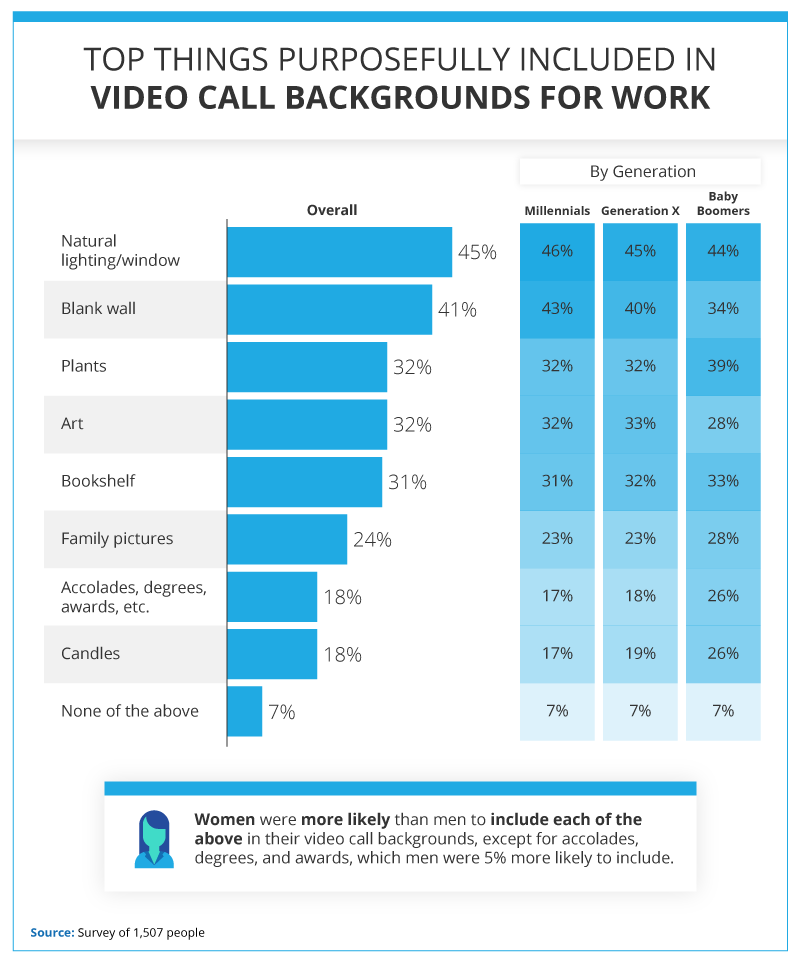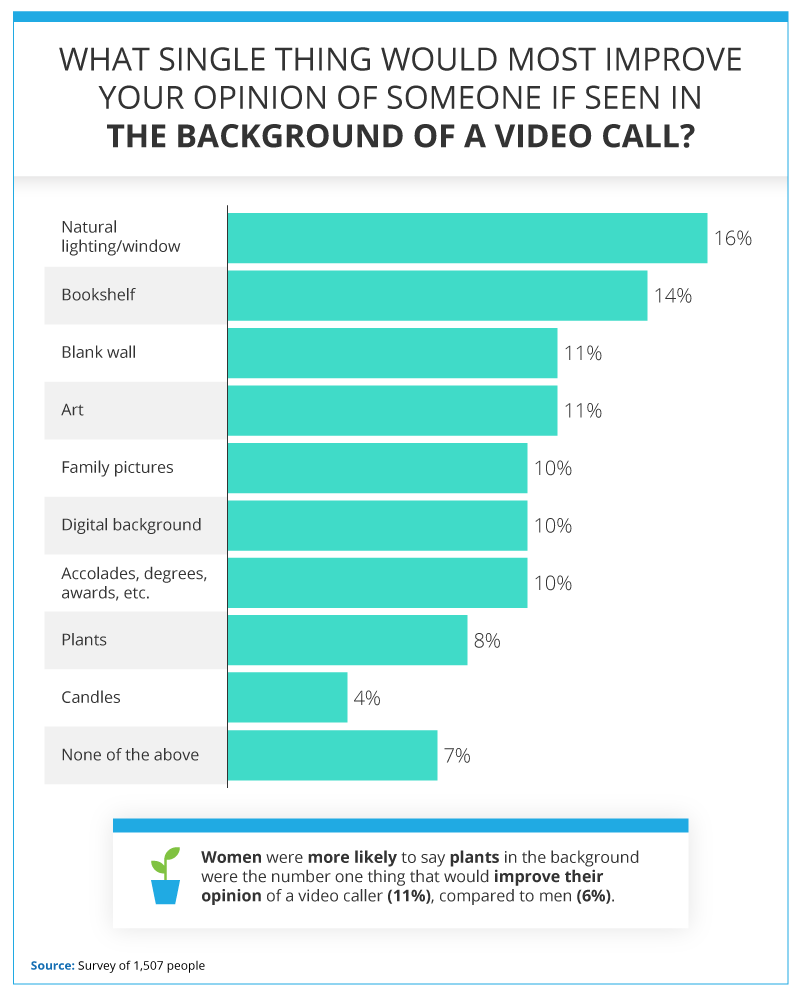
The Influence of Video Call Backgrounds
With almost half of Americans working from home since the beginning of the COVID-19 pandemic, businesses are having to find new ways to hold conferences with their employees. Most work meetings are now being conducted on video call sites, such as Zoom, while employees adhere to safety regulations.
So how does one maintain the professional atmosphere of the office while working from home? Many individuals may have children at home. There may be toys strewn on the ground, unfolded laundry on the couch, or toddlers flinging food.
Thankfully, Zoom has created an option that allows users to add a background photo to their video call. This way, people can hide distracting items in the background of the frame in order to prevent sidetracking co-workers from the work at hand.
We became curious whether the photo someone put as their Zoom background had any effect on how others in the call perceived that person. We surveyed over 1,500 Americans to determine if different photos had any influence on one's perceived intelligence, approachability, trustworthiness, and professionalism.
Which background was perceived as best in these four categories?
Each photo featured the same model – one male and one female – in the same pose. The A/B tests, also known as split tests, were randomized, with each of our 1,507 respondents being shown one of the photos below.

After being shown a photo, participants were asked to rate the model in the foreground on the four above-mentioned traits. After being collected, the ratings were then weighted so both male and female models were equal.
In contrast to typical gender stereotypes in the workplace, our female model scored the highest ratings in all four categories: most approachable, most intelligent, most trustworthy, and most professional. Though this could potentially have to do with a number of variables – glasses, clothing, facial expression – it was an interesting result regardless.
The woman in front of the indoor plants was rated as most intelligent, most approachable and most trustworthy. And the woman in front of the bookshelf was seen as most professional.
What backgrounds are best overall?
While some backgrounds might make one seem more intelligent, more trustworthy or more professional, which type of background should someone use to make them seem better overall? And what attributes does it enhance to set them apart from their peers?
The A/B test was used again for this survey, showing participants two models in front of six different backgrounds. Each model was rated on the four above-mentioned traits on a scale from 1 (not at all) to 5 (extremely). The scores from both the male and female model were then averaged to produce the final score for each background.
We again wanted to see if having various objects in the background made the models stand out more to survey respondents, as opposed to having a blank wall in the background. Every background tested ended up rating higher for making the model seem more intelligent, trustworthy, approachable, and professional. However, models in front of the book shelf were rated as less approachable than models in front of the blank wall.
Since more people are working from home due to the COVID-19 pandemic, some may have rushed to set their laptops up in front of their bookshelves, hoping to make them seem more credible and well-rounded. However, viewers might actually get distracted from the meeting's agenda, curious to see what books the employee owns. In fact, people can end up being ridiculed based on what books they display, possibly being seen as a "try hard." Therefore, while a bookshelf may make someone seem more intelligent, that plan may backfire and land them seeming less approachable (and with judgmental co-workers).

Plants had the highest rating in 3 of 4 categories. Models who were placed in front of the indoor plant background were viewed as the most intelligent, trustworthy, and approachable. They only had a .02 lower rating than bookshelves in terms of professionalism. This could be due to the increased popularity of houseplants since the COVID shutdown and quarantine in March.
Models with windows or natural lighting in the frame rated well in terms of trust, intelligence, and approachability. Models with candles lighting their frame were also rated fairly well in those three categories, but scored very low in terms of professionalism.
Is it normal to stage your Zoom background?
Some people may spend ten minutes making sure the background for their video call is neat and tidy, while others may simply set up their call in a given location without regard for what's in the frame. How normal is it for someone to have an arranged space for work calls?

Only 40% of survey respondents claimed to always or fairly often set up an appointed Zoom call space. Thirty-five percent of respondents reported they sometimes set up a call space, and 26% said they rarely or never do.
Women were only slightly more likely than men to set up a space for their Zoom call, with only a 6% difference between them.
Overall, 71% of people had spent time adjusting the lighting before a work call to make themselves seem more presentable. More than half reported cleaning up their call area, as well as adding or removing certain items they deem unnecessary or to appear more professional-looking. Sixty percent of respondents said they take time to adjust their webcam before a call to find a good angle of themselves and the room. Only 36% said they move to various locations in their house to find the most aesthetic setting before a Zoom call starts.
What do people purposefully put in their frame?
As seen in the graphic above, 56% of respondents admitted to adding or removing things from their Zoom frame in order to obtain a certain appearance. So we were curious – what kinds of things do people purposely put in their frames?

Almost half of survey respondents said they try to take calls by a window or in a room filled with natural light. Surprisingly, 41% try to take calls with a blank wall as a background, although, as we found, a blank wall got the lowest ratings among our four desirable Zoom call traits.
Approximately the same number of respondents intentionally had plants, art, or bookshelves behind them during their meetings. About a quarter of our respondents said they place family photos in their background. Out of all the things to purposefully place, degrees, awards, and candles were the least likely to be put in our respondents' backgrounds (18% each), and 7% claimed they don't purposely put anything in the background for their Zoom calls.
We did not find that any particular age group was significantly more likely to add things to their backgrounds than others. The only major difference was baby boomers were almost 10 percentage points more likely to place degrees or awards in their background, as well as use candles to accentuate their frame.
Men were five percentage points more likely to include degrees and awards in their backgrounds, whereas women were more likely to add every other object inquired about.
What really improves the impression you give in your meetings?
We then decided to ask survey respondents for their own opinion: What things, if seen in the background of someone else in a virtual meeting, would improve your opinion of that person?

Most participants cited natural light or windows as aspects that would improve their impression of someone on a video call. Regardless of the negative effect bookshelves could potentially have, 14% said they would improve their opinion of someone. Despite what our study found, blank walls (along with art) ranked third highest on things that would improve someone's opinion of another Zoom call attendee.
Plants, although ranking highly previously, only had 8% of respondents saying indoor foliage would improve their opinion of someone, including twice as many women than men.
Family photos, degrees, and digital backgrounds scored similarly, while candles garnered a vote three percentage points lower than ‘none of the above' items.
Is there really a ‘best' background?
While there are certainly some backgrounds that might make an individual stand out more, there is no way to define what the best background is.
If someone is looking to have a better overall appearance during their Zoom calls, having a naturally-lit frame can help reduce harsh light and smooth out blemishes.
Adding objects such as plants, bookshelves, or degrees may make you seem more professional or trustworthy, but keeping a clean blank wall behind you can also raise your co-workers' opinions of you.
As long as your background is clean and free of distractions, you more than likely can't go wrong.
About Signs.com
People will continue working remotely for a long time to come. At Signs.com, we offer wall decals, step and repeats and fabric banners that can help enhance your work space to make you look your best on Zoom calls. To view our wide selection of items, visit us at www.signs.com.
Methodology and Limitations
We conducted a survey of 1,507 people who participate in video calls for work on a monthly basis or more frequently. Respondents were then asked to answer questions about video call backgrounds and video call behavior.
The scores for video caller traits of intelligence, trustworthiness, approachability, and professionalism by different video call backgrounds were collected through an A/B test. Twelve unique mock-ups of a video call were created using two models (one male and one female) and six different video call backgrounds. The backgrounds showed the same male or female model in front of a window/natural light, indoor plants, a bookshelf, candles, art pieces, and a blank wall. Each respondent saw only 1 of 12 images and was asked the degree to which they would describe the model as intelligent, trustworthy, approachable, and professional, from 1 (not at all) to 5 (extremely). The results were weighted evenly between male and female models for each background type. Averages of both models were used to determine the scores for background types.
Fifty-seven percent of respondents identified as male, 43% identified as female, and less than 1% identified as a gender not listed by our study.
Sixty percent of respondents identified as millennials, 28% as Generation X, and 8% as baby boomers. Five percent of respondents belonged to other generational groups with insufficient sample sizes.
Respondents ranged in age from 18 to 75 with a mean of 36.6 and a standard deviation of 10.5.
It is possible that with a greater sample of respondents, we may have been able to gain better insight into these demographics.
The results of this study are based on means alone. No statistical testing was performed. As such, the information on this page is for informational purposes.
The data we are presenting rely on self-report and are susceptible to issues, such as selective memory, telescoping, attribution, and exaggeration.
Fair Use Statement
Know someone who might need some advice on upping their virtual call backgrounds? Feel free to share this study and link back to this page so the full study can be explored and the authors can get the proper credit.


 Fastest Growing Private Companies in America
Fastest Growing Private Companies in America